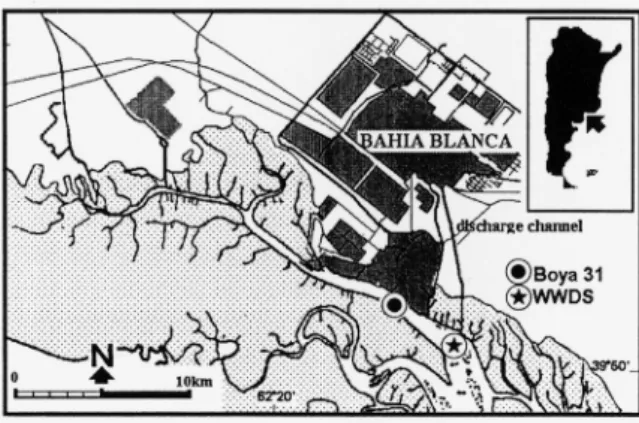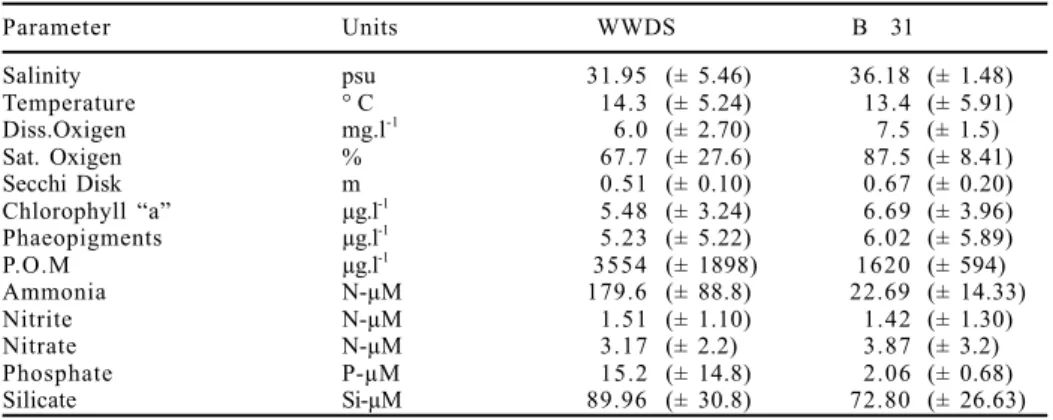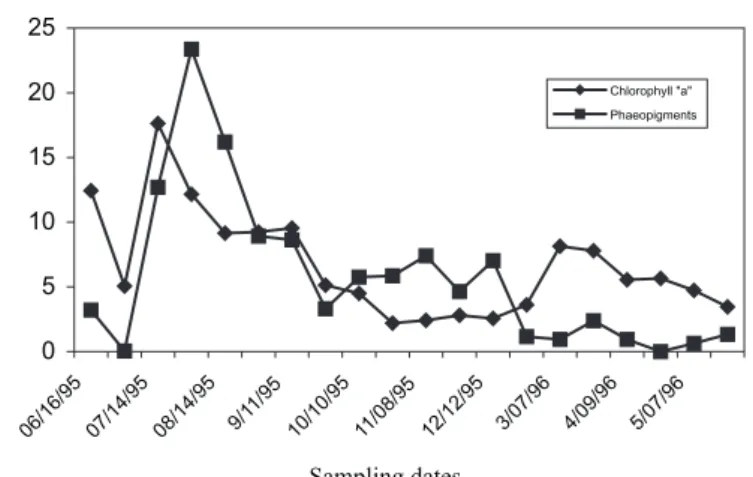ABUNDANCE AND SPECIES COMPOSITION OF PLANKTONIC
CILIOPHORA FROM THE WASTEWATER DISCHARGE ZONE IN THE
BAHÍA BLANCA ESTUARY, ARGENTINA
María Sonia Barría de Cao
1, 2Rosa Pettigrosso
2Elisa Parodi
1, 2, 4Rubén Freije
3ABSTRACT
The specific composition and abundance variation of the ciliate community from a wastewater discharge zone in the Bahía Blanca estuary, Argentina, were studied all throughout a year, from June 1995 to May 1996. The polluted area exhibited high values of particulate organic matter and nutrients, particularly phosphates. Aloricate ciliates were represented by 15 species belonging to the genera Strombidium Claparède &Lachmann, 1859; Strombidinopsis Kent, 1881; Cyrtostrombidium
Lynn &Gilron, 1993; Strobilidium Schewiakoff, 1983; Lohmmanniella Leegaard, 1915 and Tontonia
Fauré-Fremiet, 1914. Tintinnids were represented by nine species belonging to the genera Tintinnidium
Kent, 1881, Tintinnopsis Stein, 1867 and Codonellopsis Jörgensen, 1924. The total abundance of aloricate ciliates reached a peak of 1,800 ind. l-1 and the total abundance of tintinnids reached a peak of 9,400 ind. l-1. Tintinnidium balechi Barría de Cao, 1981 was the most abundant ciliate in the community. Considerations on the presence and abundance of ciliates are made in relation to physicochemical and biochemical parameters.
KEYWORDS. Tintinnina, Ciliophora, wastewater, estuaries.
INTRODUCTION
The major source of organic pollution in the world is domestic sewage (C
URDS,
1982). In coastal areas, it is common for untreated sewage to be passed directly to the sea.
Such is the case in Bahía Blanca City, Argentina. Sewage contains large amounts of
organic matter, which, when utilized by bacteria, reduces the dissolved oxygen levels in
the aquatic environment. This fact can cause great damage to marine organisms. The
disposal of sewage in the sea is considered to be the major source of addition of nitrogen
and phosphorous compounds to the aquatic environment. Wastes discharged into the
sea cause eutrophication, which modifies the planktonic populations in coastal waters
1. Instituto Argentino de Oceanografía (I.A.D.O.), Camino La Carrindanga km 7, Casilla de Correo 804, 8000, Bahía Blanca, Argentina. (sbarria@criba.edu.ar)
both quantitatively and qualitatively. Some planktonic ciliates can live in highly eutrophic
waters; hence, they can be used as indicators of organic pollution. Bacterivorous ciliates
can reach the highest standing stocks among the pelagic ciliates in some estuarine zones,
and should be able to consume one third of annual bacterial production (A
RNDTet al
.,
1990), so they play an important role in regulating the growth of bacteria populations
(R
IVIERet al
., 1985).
The subject of planktonic ciliates in relation to organic pollution has not been
studied in the coasts of Argentina, with the exception of the Río de La Plata coast (R
IVES,
1997).
The aim is to analyze the composition and abundance variation of the planktonic
ciliate community in the wastewater discharge zone of the Bahía Blanca estuary in relation
to physicochemical and biochemical parameters.
MATERIAL AND METHODS
The studied area is located in the inner part of the Bahía Blanca estuary (38,8°S, 62,2°W) (fig. 1). To compare results, sampling was carried out at two fixed stations, one in the wastewater discharge zone (WWDS) and the other (Boya 31) in the principal channel of navigation. The wastewater discharge zone is affected by untreated sewage from Bahía Blanca, a city with a population of approximately 350,000 inhabitants (80% of them within the sanitation network).
Samples were collected from 16 June 1995 to 20 May 1996 at two fixed stations approximately every 15 days with a 30 µm mesh plankton net and a Van-Dorn bottle and then fixed with 4 % formaldehyde solution and Lugol's solution, respectively. Observations were made with a contrast-phase microscope, and ciliates were counted with an inverted microscope following the Utermöhl method (HASLE, 1978).
Water temperature, salinity, turbidity, particulate organic matter (POM), nutrients (ammonia, nitrite, nitrate, phosphate, and silicate), Chlorophyll “a”, and phaeopigments were measured at both stations on each sampling date.
Nutrients were determined using a Technicon Auto Analyzer II, according to TREGUER & LE CORRE
(1975), EBERLEIN & KATTNER (1987) and GRASSHOFF (1983). Chlorophyll “a” and phaeopigments were measured after LORENZEN (1967). Other determinations were performed according to STRICKLAND &
PARSONS (1968). A correlation test was done between the total abundance of tintinnids, the total
abundance of aloricate ciliates, the abundance of Tintinnidium balechi at WWDS, and the physicochemical and biochemical parameters.
RESULTS
The data obtained for
physico-chemical parameters
(tab. I) showed main differences
on phosphate and silicate
values, which were always
higher at WWDS (figs. 2, 4).
Registered POM data were
rather erratic but nearly always
higher at WWDS. Chlorophyll
“a” and phaeopigments
showed a similar trend at both
sampling stations (figs. 3, 5) with
maximal values in winter.
During the study, the aloricate ciliates group was represented by Choreotrichida
and Oligotrichida, and the species found belong to the genera:
Strombidium
Claparède &
Lachmann, 1859;
Strombidinopsis
Kent, 1881;
Cyrtostrombidium
Lynn & Gilron, 1993;
Strobilidium
Schewiakoff, 1983;
Lohmmanniella
Leegaard,
1915 and
Tontonia
Fauré-Fremiet, 1914 (figs. 6-9).
The estimated total abundance of aloricate ciliates varied between a minimum of 100
ind. l
-1and a maximum of 3,700 ind. l
-1, the latter being registered at the Boya 31 Station,
where the total number of individuals was always higher than that at WWDS. Values
registered at WWDS varied from 100 ind. l
-1to 1,800 ind. l
-1(fig. 12).
Strombidinopsis
and
Strombidium
were the most widely represented genera, and
both were present at the two stations during the sampling period.
Strombidium
reached
the highest abundance levels at both stations, representing 37% of the total abundance,
while
Strombidinopsis
reached 30%. The other genera showed relative abundances that
were slightly higher at WWDS, with the exception of
Cyrtostrombidium
, which was
found to have twice the number of individuals at Boya 31 (fig. 13).
Eleven species of tintinnids were encountered in the principal channel of navigation
(Boya 31) of the Bahía Blanca estuary:
Tintinnidium balechi
Barría de Cao, 1981;
T.
aff
.
semiciliatum
;
Tintinnopsis baltica
Brandt, 1896;
T. beroidea
Stein, 1867;
T. brasiliensis
Kofoid & Campbell, 1929;
T. glans
Meunier, 1919;
T. gracilis
Kofoid & Campbel, 1929;
T.
levigata
Kofoid & Campbell, 1929;
T. parva
Merkle, 1909;
T. parvula
Jörgensen, 1912 and
Codonellopsis lusitanica
Jörgensen, 1924. Nine species were sporadically represented
at the wastewater discharge station (figs. 9-11):
Tintinnidium balechi,
T.
aff
.
semiciliatum
,
Tintinnopsis baltica,
T. beroidea,
T. brasiliensis,
T. glans,
T. gracilis,
T. parva
and
Codonellopsis lusitanica
. The total amount of tintinnids reached a peak of 9,400 ind. l
-1at
WWDS, and the highest value observed was of 8,200 ind. l
-1at Boya 31 in spring (fig. 14).
These peaks were almost exclusively due to
T. balechi
, which was the most conspicuous
component of the tintinnid community and was present throughout the sampling period
at WWDS.
Tintinnidium balechi
reached percentages over 90% of the total abundance
of tintinnids at this station (fig. 14) while it never exceeded 51% of the total abundance of
tintinnids at Boya 31.
Table I. Physicochemical and biochemical parameters measured at the wastewater discharge zone (WWDS) and a reference station (Boya 31). Mean values and S.D. (in brackets).
Parameter Units WWDS B 31
Salinity psu 31.95 (± 5.46) 36.18 (± 1.48)
Temperature ° C 14.3 (± 5.24) 13.4 (± 5.91)
Diss.Oxigen mg.l-1
6.0 (± 2.70) 7.5 (± 1.5)
Sat. Oxigen % 67.7 (± 27.6) 87.5 (± 8.41)
Secchi Disk m 0.51 (± 0.10) 0.67 (± 0.20)
Chlorophyll “a” µg.l-1
5.48 (± 3.24) 6.69 (± 3.96)
Phaeopigments µg.l-1
5.23 (± 5.22) 6.02 (± 5.89)
P.O.M µg.l-1
3554 (± 1898) 1620 (± 594)
Ammonia N-µM 179.6 (± 88.8) 22.69 (± 14.33)
Nitrite N-µM 1.51 (± 1.10) 1.42 (± 1.30)
Nitrate N-µM 3.17 (± 2.2) 3.87 (± 3.2)
Phosphate P-µM 15.2 (± 14.8) 2.06 (± 0.68)
0 5 10 15 20 25 06/ 16/95 07/ 14/95 08/ 14/95 9/11/ 95 10/ 10/95 11/08/ 95 12/ 12/95 3/07/ 96 4/09/ 96 5/07/ 96 Chlorophyll "a" Phaeopigments
S i g n i f i c a n t
correlation values were
found between the
abundance of tintinnids,
the abundance of the
aloricate ciliates, and the
abundance of
Tintinnidium
balechi
, and some of the
p h y s i c o c h e m i c a l
parameters (tab. II).
DISCUSSION
In general, the total
abundance values of
aloricate ciliates registered
at Boya 31 Station were
similar to the values
observed in other areas of
the estuary (P
ETTIGROSSOet
al
., 1997).
Analysis of seasonal
variation of ciliate
abundances showed that
values from both stations
were low in winter and
tended to increase in spring,
reaching the highest peak in
summer. The lowest
abundances during winter
coincided with the annual
period of phytoplankton
bloom. This behavior has
been formerly observed in
the inner part of the estuary
(P
ETTIGROSSOet al
., 1997).
The total abundance of
aloricate ciliates presented
significant positive
correlation values with
salinity and negative
correlation with POM and
phosphate. The constant
presence of
Strombidium
and
Strombidinopsis
with
high abundance values at
0 5 10 15 20 25 30 35 40 45 50 06/16/ 95 07/14/ 95 08/14/ 95 9/11/ 95 10/10/ 95 11/0 8/95 12/12/ 95 3/07/ 96 4/09/ 96 5/07/ 96 Nitrite Nitrate Phosphate Silic/10 2 3 4Figs. 2-4. 2, Nutrients variation at WWDS (wastewater discharge station); 3, chlorophyll “a” and phaeopigments variation at WWDS; 4, nutrients variation at Boya 31 station.
Fig. 5. Chlorophyll “a” and phaeopigments variation at Boya 31 station. 0
5 10 15 20 25
06/16/95 07/14/95 08/14/95 9/1 1/95
10/10/95 11/08/95 12/12/95 3/07/96 4/09/96 5/07/96
Sampling dates
Chlorophyll "a" Phaeopigments
Figs. 12-14. 12, Total abundance of aloricate ciliates; 13, relative abundance in percentage of aloricate ciliates species; 14, total abundance of tintinnids and relative abundance in percentage of T. balechi.
0 1000 2000 3000 4000 5000 6000 7000 8000 9000 10000 6/16/ 95 7/14/ 95 7/28/ 95 8/14/ 95 8/28/ 95 09/11/ 95 9/27/ 95 10/11/ 95 10/26/ 95 11/08/ 95 11/2 7/95 12/12/ 95 2/21/ 96 03/07/ 96 3/22/ 96 04/09/ 96 4/19/ 96 05/07/ 96 5/20/ 96 Sampling dates Nº ind. l -1 0 10 20 30 40 50 60 70 80 90 100 Percentage Boya 31 WWDS T.bal. WWDS T. bal. Boya 31 0
1000 2000 3000 4000
6/16/95 7/28/95 8/28/95 9/27/95 10/26/95 11/27/95 2/21/96 3/22/96 4/19/96 5/20/96
both stations most of the time could indicate
certain tolerance of these genera to high
levels of organic matter and salinity
variations. Even though represented by a
smaller number of individuals, the genera
Strobilidium
,
Lohmmanniella
, and
Tontonia
also appear to tolerate variations in the
parameters considered in this study. The
exception was
Cyrtostrombidium
, whose
abundance was decreased by 50% at
WWDS, demonstrating its high sensitivity
to high organic matter levels and low salinity
values.
Reports on tintinnids in relation to
organic pollution are very scarce in the world.
C
URDS(1982) referred to tintinnids as
organisms highly sensitive to the presence of
sewage. It was observed the presence of 9
species of tintinnids
at WWDS, an area where
the average of organic matter was 3,554 µg. l
-1.
Most of the species found at both stations belonged to
Tintinnidium
and
Tintinnopsis
, which is a characteristic feature of the species composition of the tintinnids
community in the Bahía Blanca estuary (B
ARRÍADEC
AO, 1992). The total abundance of
tintinnids was nearly always higher at Boya 31 than at WWDS. Positive correlation
values were observed between the abundance and salinity values at WWDS, but their
abundance was negatively correlated with POM and phosphate. The peak of tintinnids
observed on 27 September 1995 at WWDS was due nearly exclusively to
Tintinnidium
balechi.
The most remarkable characteristic of the tintinnid community at WWDS was
the constant presence and high abundance values of
T. balechi
,
although its abundance
was negatively correlated with POM and phosphate. One explanation for the remarkable
occurrence of
T. balechi
at WWDS could be its specific food requirements.
Tintinnidium
balechi
is a small species with a mean oral lorica diameter of 17.3 µm and a mean peristome
diameter of only 12 µm (B
ARRÍADEC
AOet al
., 1997); therefore, its specific diet must
consist of very tiny preys. The peaks of chlorophyll “a” at both stations were found
during a phytoplankton bloom during the winter. Phytoplankton bloom in the Bahía
Blanca estuary is chiefly composed of nanophytoplankton species, but these species,
which are chain forming and projection bearing diatoms, could represent only a part of
the diet of
T. balechi
, as they are not suitable food for tintinnids in general (B
ARRÍADEC
AOet al
., 1997).
The physicochemical and biochemical characteristics at WWDS would favor the
existence of an adequate source of food such as bacteria and heterotrophic
microflagellates. Both terrestrial and marine heterotrophic aerobic bacteria develop well
in this area (C
ABEZALÍ& B
URGOS, 1988), and coliform bacteria are also very abundant
(B
ALDINI& C
ABEZALÍ, 1988).
Although there are no references on saprobity in tintinnids from marine waters, it
Table II. Significant correlation values (p < 0.5, n=19) between the total abundance of tintinnids (AT), aloricate ciliates (AAC), Tintinnidium balechi
at WWDS (ATb), and some of the physicochemical parameters.
Tintinnids
WWDS Boya 31
AT/Salinity, r=0.522 AT/POM, r=-0.558 AT/POM, r=-0.606
AT/Phosphate, r=-0.513 Aloricate ciliates
WWDS Boya 31
AAC/Salinity, r=0.550 AAC/Salinity, r=0.540 AAC/POM, r=-0.517 AAC/POM, r=0.555
AAC/Sil, r=0.507 AAC/Temp., r=0.506
Recebido em 31.12.2002; aceito em 17.02.2003.
is known that two species of
Tintinnidium
,
T. fluviatile
Kent, 1882 and
T. fluviatile
v.
emarginatum
Maskell, 1887 and one species of
Tintinnopsis
:
T
.
cylindrata
Kofoid &
Campbell, 1929, have been considered as oligo-beta-mesosaprobic in freshwater systems
(S
LADECEK, 1973; F
OISSNER, 1988).
Acknowledgments. To R. Asteasuain, C. Bernardez and W. Melo from the Instituto Argentino de Oceanografía, for chemical determinations, technical assistance during navigation and drawing the map. This research was supported by grant PGI 24-B036 of the Universidad Nacional del Sur, Argentina.
REFERENCES
ARNDT, H.; JOST, G. & WASMUND, N. 1990. Dynamics of pelagic ciliates in eutrophic estuarine waters:
importance of functional groups among ciliates and responses to bacterial and phytoplankton production. Arch. Hydrobiol. Beih. Ergebn. Limnol., Stuttgart, 34:239-245.
BALDINI, M. D. & CABEZALÍ, C. B. 1988. Distribución de Escherichia coli en aguas del estuario de Bahía Blanca, Argentina. Revta lat. am. Microbiol., Mexico D.F., 30:229-234.
BARRÍA DE CAO, M. S. 1992. Abundance and species composition of Tintinnina (Ciliophora) in Bahia
Blanca estuary, Argentina. Estuarine Coastal Shelf Sci., London, 34:295-303.
BARRÍADE CAO, M. S.; PETTIGROSSO, R. E. & POPOVICH, C. 1997. Planktonic ciliates during a phytoplankton bloom in Bahía Blanca estuary, Argentina. II. Tintinnids. Oebalia, N. Ser., Toronto, 23:21-31.
CABEZALÍ, C. B. & BURGOS, M. A. 1988. Distribución espacial y temporal de bacterias aerobias en el
estuario de Bahía Blanca, Argentina. Revta argent. Microbiol., Buenos Aires, 20:77-86. CURDS, C. 1982. Pelagic protists and pollution. A review of the past decade. Annls Inst. oceanogr.,
Paris, 58(S):117-136.
EBERLEIN, K. & KATTNER, G. 1987. Automatic method for the determination of orthophosphate and
total dissolved phosphorous in the marine environment. Fresenius Z. analyt. Chem., Berlin, 326:354-357.
FOISSNER, W. 1988. Taxonomic and nomenclatural revision of Sladecek list of Ciliates (Protozoa:
Ciliophora) as indicator of water quality. Hidrobiologia, Dordrecht, 166:1-64.
GRASSHOFF, K. 1983. Methods of Seawater analysis. New York, CEIME Verlag. 317p.
HASLE, G. R. 1978. Settling. The inverted-microscope method. In: SOURNIA, A. ed. Phytoplankton Manual. Monographs on oceanographic methodology. Paris, UNESCO. v.6, p.88-96.
LORENZEN, C. L. 1967. Determination of chlorophyll and pheopigments. Spectrophotometric equations.
Limnol. Oceanogr., Lawrence, 12:343-346.
PETTIGROSSO, R. E.; BARRÍADE CAO, M. S. & POPOVICH, C. 1997. Planktonic ciliates during phytoplankton bloom in Bahía Blanca estuary, Argentina. I. Aloricate ciliates. Oebalia, N. Ser., Toronto, 23:3-19.
RIVES, C. V. 1997. Protozoos como indicadores de contaminación. In: Calidad de las aguas de la
franja costera sur del Río de La Plata (San Fernando-Magdalena). Buenos Aires, Sec. Obras Públicas. p.113-119.
RIVIER, A.; BROWNLEE, D. C. et al. 1985. Growth of microzooplankton: a comparative study of
bactivorous zooflagellates and ciliates. Mar. Microbial Food Webs, Paris, 1:51-60.
SLADECEK, V. 1973. System of water quality from the biological point of view. Arch. Hidrobiol. Beih.
Ergebn. Limnol., Stuttgart, 7:1-218.
STRICKLAND, J. D. & PARSONS, T. R. 1968. A practical handbook of seawater analysis. Ottawa,
Fisheries Research Board of Canada. 311p. (Bulletin, 167).
TREGUER, P. & LE CORRE, P. 1975. Manuel d’analisis des sels nutritifs. Brest, Université de


